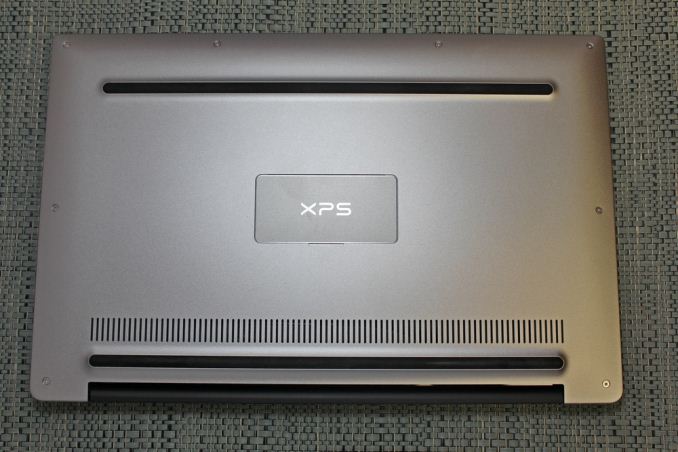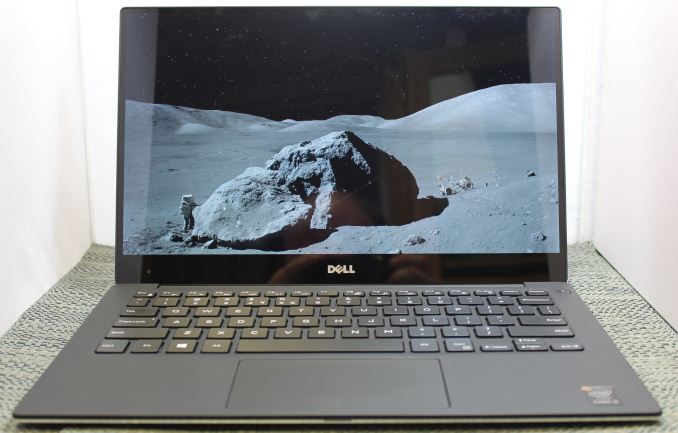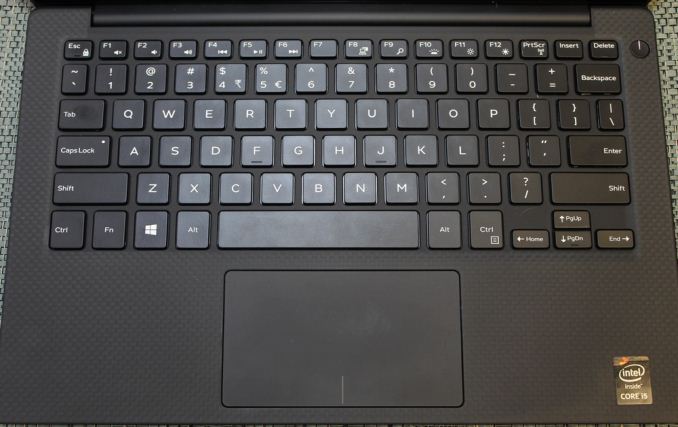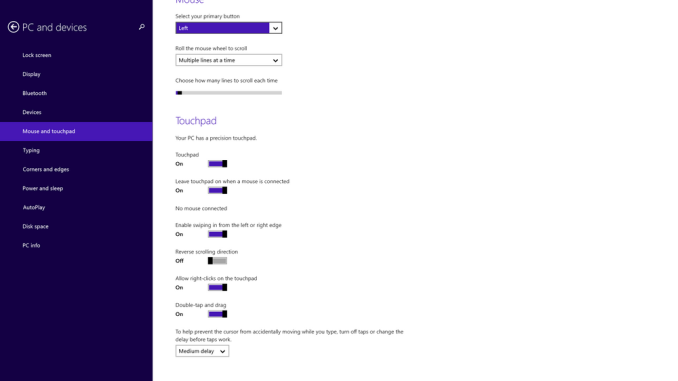Dell XPS 13 Review
by Brett Howse on February 19, 2015 9:00 AM EST- Posted in
- Laptops
- Dell
- Ultrabook
- Broadwell-U
- XPS 13
Design and Chassis
The design of the XPS 13 is the first thing you see, and you would be hard pressed to find anyone who does not think Dell has done a great job with the overall intention. From the external aluminum shell, to the carbon fibre palm rest, to the super thin bezels, the XPS 13 is undeniably a great looking laptop.
Dell has really squeezed the dimensions down for this device. To say that it is a 13 inch laptop in an 11 inch chassis, we should see just how close they got. The Dell XPS 13's dimensions are listed as 11.98 inches (304mm) wide, and 7.88 inches (200mm) deep. Compare this to the MacBook Air 13, which is 12.8 inches (325mm) x 8.94 inches (227mm), and right away it is clear that the Dell is quite a bit smaller. The MacBook Air 11 is much closer in size, at 11.8 inches (300mm) x 7.56 inches (192mm). So truly, the lack of display bezels has changed what we would think of as a 13 inch laptop. If more devices go this route, which they likely will, there will be much more display per unit of laptop going forward.
The outer shell of the XPS 13 is completely aluminum, on the top and bottom. This gives the design a premium feel with the very first touch, and compared to the plastic of most notebooks, it is a big step up in terms of materials and finish. While not milled out of a single piece of aluminum, the exterior looks and feels very nicely made. With the notebook closed, there is a black strip around the center, which gives a sharp contrast. Dell paid attention to the bottom of the device as well, with a magnetic plate, hinged on one side, covering the service tag and serial number to keep the bottom looking clean and unblemished.
The left side features the mini DisplayPort output, as well as a USB 3.0 port with PowerShare (you can charge devices while the laptop is powered off) and the headset jack. The speakers are on the sides on the XPS 13, so the left has an unobtrusive speaker grille as well as the battery meter. The right side features another USB 3.0 port, also with PowerShare, as well as the Noble lock and the SD card slot. The second speaker grille adorns the front right of the notebook. The front of the laptop has a single light, which glows when the laptop is charging and flashes yellow when the battery is critical. This makes it easy to tell when the laptop is fully charged and is a nice addition.
The underside of the XPS 13 consists of two full width rubber feet. This makes it plenty sturdy to use on almost any surface and keeps the device stable even on uneven surfaces. The fan intake and exhaust is also under the laptop, which helps keep the noise of the fan at bay. Yes, there is a fan. Broadwell-U promises to be more power efficient, but it is still rated at 15 watts so that heat must be removed.
Once you open the XPS 13, you will be face to face with the wonderful display, which takes up almost the entire width of the device. With bezels only 5.2 mm thin, Dell is marketing this as an Infinity Display, and while it is not quite the same as an Infinity Pool it is still a great effect. Laptop bezels have been quite large for a long time and this new device will hopefully usher in a push to smaller bezels on all laptops.
The XPS 13 does have a larger bezel at the bottom, which serves a couple of purposes. The extra height allows Dell to keep the depth of the laptop larger, which makes more room for the trackpad, and the front facing camera also finds its home in the bottom bezel. This does make it less effective though, and perhaps Dell can find a way to squeeze it back on top without adding too much thickness to the top bezel.
The keyboard is an island style, completely surrounded in carbon fiber. This is then covered with a soft touch paint, which makes it a lot more comfortable to type on than something with an aluminum top and sharp sides. The weave of the carbon fiber still shows through and gives it a great look. The keyboard itself is also quite good for an Ultrabook and the small travel that they entail. The key layout is also fairly standard, and while I prefer dedicated Page Up/Down, Home , and End keys, that would be tough to do on a laptop this small without sacrificing something else. The up/down/left/right keys are well placed and easy to use.
Below the keyboard is the clickpad. Dell has opted to forego the third party drivers and sticks with the Microsoft Precision trackpad model. This moves the settings into Windows and makes them more consistent. There seems to have been no issue with doing this, as the clickpad was responsive and accurate. I do prefer dedicated buttons, but on a device this small that would take away too much trackpad space, so a clickpad is the better choice here.
Overall, Dell has created a great design in the XPS 13. It keeps with some of the Dell traditional designs, but the sharper edges and smaller radius corners contribute to an overall better look. That coupled with the premium feel of the materials, the good keyboard and trackpad, and the very small display bezels, make the XPS 13 one of the more attractive laptops around.

















201 Comments
View All Comments
jospoortvliet - Friday, March 27, 2015 - link
Somebody bothered, years ago: Samsung series 9. Where they beat Dell to small bezels, they also announced the series 9 2015 model in December 2014: 12" screen, under 1 kg (2 lbs), passively cooled core M, high res screen and long battery life. Yeah, that is Apple's new MacBook, just three months earlier.Series 9 had been and continues to be ahead 😃
jospoortvliet - Friday, March 27, 2015 - link
Somebody bothered, years ago: Samsung series 9. Where they beat Dell to small bezels, they also announced the series 9 2015 model in December 2014: 12" screen, under 1 kg (2 lbs), passively cooled core M, high res screen and long battery life. Yeah, that is Apple's new MacBook, just three months earlier.Series 9 had been and continues to be ahead 😃
retrospooty - Thursday, February 19, 2015 - link
Looks like some great specs and a great laptop... Hopefully it doesn't suffer from the odd glitches and high fail rates that some (not all) Dell products suffer from. Time will tell.programcsharp - Thursday, February 19, 2015 - link
I like this, but what I really want is a 15" version with a bit more oomph. The 13" ends up being cute but pricey.Do a 15" QHD+ version with an i7, 512gb ssd and 32 gb RAM and now we're talking.
esterhasz - Thursday, February 19, 2015 - link
Not to forget: all you're saying, and in the footprint of a 13" machine!andrewaggb - Thursday, February 19, 2015 - link
agreed. A 15" (13" frame) machine would be great.jeffkibuule - Thursday, February 19, 2015 - link
Quad core Broadwell chips still haven't shipped, which is why we probably haven't seen a new 15" laptop from any major OEM yet.I'm also not sure we will get 32GB in a mainstream laptop yet, seems 16GB is still the top for the high end. Maybe with DDR4?
UtilityMax - Wednesday, February 25, 2015 - link
The statement that a 15 inch laptop needs a quad-core CPU is a little perplexing. The only quad-core Intel CPUs for laptops are the high wattage versions of the Core i7 CPUs, and they represent a valuable but very small portion of the market. More and more high end laptops ship with the "U" series if Core i7 CPUs, which are dual core, even in machines that are meant to replace quad-core offerings. The value is multiple cores is seriously over-hyped as far as desktops are concerned. Lots of applications are still single threaded, or multithreaded where one core still bottlenecks the main thread. Two fast cores are plenty for most laptop and tablet users, specially if that saves battery life.extide - Thursday, February 19, 2015 - link
Yeah, 8GB is just not going to do it for me these days. 16GB min, and 32GB preferred. Also I would like a 35w quad core, instead of a U-series. However I DO NOT want discrete graphics! It seems like pretty much all laptops with 35/45w quads have discreet graphics as well. I think Clevo makes a model (Haswell) that is like this, though. Although Clevo machines are great in the fact you can customize the crap out of them, their all-plastic build makes them a bit fragile. I have a P150EM (Ivy Bridge) and I am nearly afraid to take it around much, because I don't want it to get damaged, vs my work laptop which is a Latitude E6530 which is a straight up tank, I mean I can/have dropped it, kids walk on top of it, and no damage whatsoever. Any of that crap to my P150EM, and something will break!aryonoco - Thursday, February 19, 2015 - link
I would have bought this laptop (with i5, QHD display and 256GB SSD) in an instant if it had 16GB version.The way I use my computer, I've got a lot of applications and generally over 20 tabs open at any times, sometimes 50-60 when I'm in the middle of research. I just can't live with 8GB.
Pity, cause it's an excellent laptop otherwise. Maybe the Skylake update will bring a 16GB option.